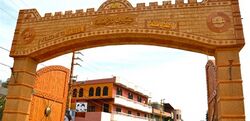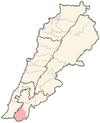عيترون
عيترون
Aitaroun | |
|---|---|
قرية | |
 | |
| الإحداثيات: 33°07′N 35°28′E / 33.117°N 35.467°E | |
| موقع الجريدة | 194/279 PAL |
| البلد | |
| المحافظة | محافظة النبطية |
| القضاء | قضاء بنت جبيل |
| المنسوب | 630 m (2٬070 ft) |
| التعداد (2002) | |
| • الإجمالي | 20٬000 |
| منطقة التوقيت | UTC+2 (EET) |
| • الصيف (التوقيت الصيفي) | UTC+3 (EEST) |
| Dialing code | +961 |
عيترون هي احدى القرى اللبنانية في قضاء بنت جبيل في محافظة النبطية.
الآثار
تضم عيترون تشكيلة من المواقع الأثرية، كثير منها نهبه الإسرائيليون أثناء الاحتلال الإسرائيلي لها لمدة 22 سنة. المواقع الأثرية التي لم تتأثر مازالت متواجدة.
اللقى الأثرية المزعومة في القرية
An approximate 3m long, white-limestone sarcophagus with Christian carvings. It is described to have had lions heads, one on each side, and a carving of what is believed to be a knight with a sword.
A foundation stone of a synagogue that once existed in the village and that is considered to be around 600 years old.[بحاجة لمصدر]
نظريات وراء المواقع الأثرية في القرية
There are several theories behind the archaeological sites in Aitaroun. One theory is that the village was a pilgrimage site for early Christians and for its water sources, some of which are believed to have been visited by Jesus. This is supported by other archaeological sites in surrounding villages. Another theory is that the village was an ancient grave yard and an important trade route due to the water sources.[بحاجة لمصدر] Another theory is that the hills surrounding the village had been military outposts for ancient armies. The village is surrounded by rocky hills with narrow valleys as entrances, and this would have made it an easy place to protect from the high ground. Evidence of such outposts also exist on the tops of the surrounding hills. Another theory is that the village was part of a Roman olive and vineyard plantation outpost.
The village was mined for marble and there is evidence of vineyards. The variants of olives currently grown in the area also seem to be of Italian varieties grown for the purpose of olive oil.[بحاجة لمصدر]
There are historic locations of reservoirs, aqueducts or sources of water in the area, many have dried up.[بحاجة لمصدر]
التاريخ
العصر العثماني
In 1596, it was named as a village, ’Aytarun in the Ottoman nahiya (subdistrict) of Tibnin under the liwa' (district) of Safad, with a population of 91 households and 15 bachelors, all Muslim. The villagers paid taxes on agricultural products, such as wheat, barley, goats, and beehives, in addition to "occasional revenues” and a fixed sum; a total of 14,570 akçe.[1][2]
Visiting in 1875, Victor Guérin described it as a village with 200 Metualis.[3]
In 1881, the PEF's Survey of Western Palestine (SWP) described it: "A large village, built of stone, containing 400 Moslems, situated in bed of wady, with olives, gardens and arable land. Water from a large birket and cisterns."[4]
نزاع جنوب لبنان 1985 وأعقابه
During the South Lebanon conflict (1985–2000) Aitaroun was part of the South Lebanon security belt. Around 20 soldiers of the South Lebanon Army were kidnapped by Hezbollah in the final year of the war.[5]
النزاع الإسرائيلي-اللبناني 2006
During the 2006 Israel-Lebanon conflict, on July 16, 12 civilians from the Akhrass family, including 7 Canadian nationals, were killed when their Aitaroun home were destroyed in Israeli airstrikes .[6] On July 18, 9 civilians from the Awada family were killed after Israeli air-strikes against their homes.[7] On July 19, 6 civilians were killed and 8 wounded by Israeli strikes, while they were trying to flee from Aitaroun.[8]
The village lost 41 villagers to the war new figures said. Families laid flowers and read Quranic verses at the graves on October 23, 2006, which marks the Eid ul-Fitr-holiday.[9]
التعداد
Aitaroun had a total population estimated at 20,000 in 2002. However, the actual number of residents is now considered to be significantly higher. The non-resident population is divided between emigrants and internal migrants distributed throughout Lebanon. Approximately 45% of the population is under the age of 30 and the average family size is 6-7 members.[بحاجة لمصدر]
الاقتصاد
تعتمد معظم العائلات على زراعة التبغ مصدراً رئيسياً للدخل. During 1978 to 2000, the village received a significant cash flow from enlistment in the Israeli funded South Lebanon Army and through work in Israel.
الإسكان والبنية التحتية
There are around 1,300 homes in the village. An electrical network was established in 1964 and access to telecommunications is fully restored since 2006. In 2005 a telephone exchange was installed in the village offering connectivity to Lebanon's telephone network. Mobile communications and internet connectivity were also fully restored.
During the occupation, potable water in the village was provided by water wells drilled in the village by Israel. The main water source is the collection of rain water which is stored in both private and public reservoirs.[بحاجة لمصدر]
الحكومة والخدمات الاجتماعية
There are five schools operating in Aitaroun: two public and three private. Public schools, elementary and intermediate, encompass 250 students, with a higher percentage of girls especially for the intermediate level. The total number of students in the private schools amount to 570 distributed among one elementary school and two intermediate schools. The village has one health center operated by the Ministry of Social Affairs. The municipal council in the village was established in 1961.
النبيت
The area is rich in wild herbs, flowers and mushrooms. Particularly prevalent are the red poppy flower, wild capers and thistles. Other flora that are believed to be more agricultural or introduced, include; grape vines, pomegranate trees, figs, cactus apple, sumac, various wild berries.
المراجع
- ^ Hütteroth and Abdulfattah, 1977, p. 179
- ^ Note that Rhode, 1979, p. 6 Archived 2019-04-20 at the Wayback Machine writes that the register that Hütteroth and Abdulfattah studied was not from 1595/6, but from 1548/9
- ^ Guérin, 1880, p. 373
- ^ Conder and Kitchener, 1881, SWP I, p. 201
- ^ "Refworld | Lebanon: Treatment of informants for the South Lebanese Army (SLA) by Amal Movement, Hezbollah Movement, the Syrian Army in Lebanon and the Lebanese authorities (1991-2001)".
- ^ HRW, 2007, pp. 98-100
- ^ HRW, 2007, pp. 100-101
- ^ HRW, 2007, pp. 153-155
- ^ "Violence casts shadow on normally festive Muslim holiday in Mideast". CBS. 23 October 2006.[dead link]
وصلات خارجية
- Survey of Western Palestine, Map 4: IAA, Wikimedia commons
- Aaytaroun, Localiban
- Video of a drive through the area
- Photomontage of the area's scenery
- http://www.ilo.org/public/english/standards/ipec/simpoc/lebanon/ra/tobacco.pdf
| هل أنت مهتم ببلد الأرز لبنان ؟ ستجد الكثير من المعلومات عنه في بوابة لبنان. |
- Pages using gadget WikiMiniAtlas
- Articles with dead external links from June 2017
- Short description is different from Wikidata
- Coordinates on Wikidata
- Articles with unsourced statements from July 2014
- Articles with unsourced statements from July 2015
- Articles with unsourced statements from July 2011
- أماكن مأهولة في قضاء بنت جبيل
- أماكن مأهولة في لبنان

